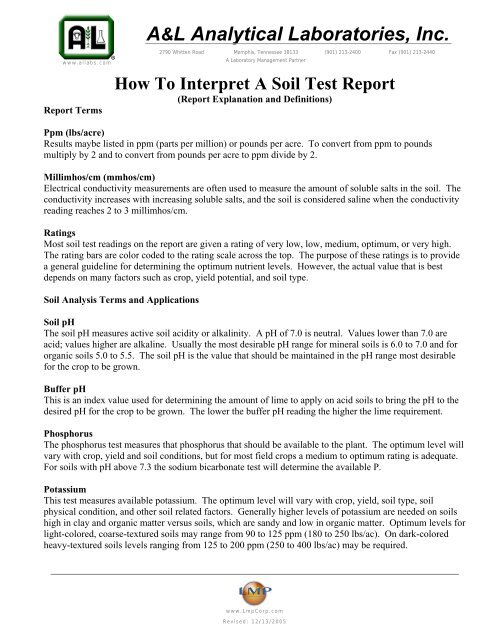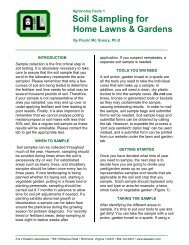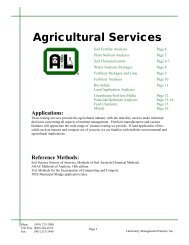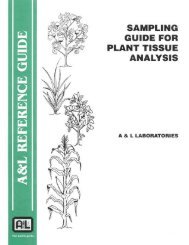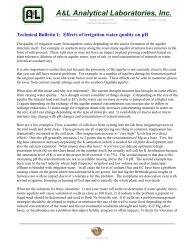Interpret A Soil Test - A&L Analytical Laboratories, Inc.
Interpret A Soil Test - A&L Analytical Laboratories, Inc.
Interpret A Soil Test - A&L Analytical Laboratories, Inc.
You also want an ePaper? Increase the reach of your titles
YUMPU automatically turns print PDFs into web optimized ePapers that Google loves.
A&L <strong>Analytical</strong> <strong>Laboratories</strong>, <strong>Inc</strong>.www.allabs.comReport Terms2790 Whitten Road Memphis, Tennessee 38133 (901) 213-2400 Fax (901) 213-2440A Laboratory Management PartnerHow To <strong>Interpret</strong> A <strong>Soil</strong> <strong>Test</strong> Report(Report Explanation and Definitions)Ppm (lbs/acre)Results maybe listed in ppm (parts per million) or pounds per acre. To convert from ppm to poundsmultiply by 2 and to convert from pounds per acre to ppm divide by 2.Millimhos/cm (mmhos/cm)Electrical conductivity measurements are often used to measure the amount of soluble salts in the soil. Theconductivity increases with increasing soluble salts, and the soil is considered saline when the conductivityreading reaches 2 to 3 millimhos/cm.RatingsMost soil test readings on the report are given a rating of very low, low, medium, optimum, or very high.The rating bars are color coded to the rating scale across the top. The purpose of these ratings is to providea general guideline for determining the optimum nutrient levels. However, the actual value that is bestdepends on many factors such as crop, yield potential, and soil type.<strong>Soil</strong> Analysis Terms and Applications<strong>Soil</strong> pHThe soil pH measures active soil acidity or alkalinity. A pH of 7.0 is neutral. Values lower than 7.0 areacid; values higher are alkaline. Usually the most desirable pH range for mineral soils is 6.0 to 7.0 and fororganic soils 5.0 to 5.5. The soil pH is the value that should be maintained in the pH range most desirablefor the crop to be grown.Buffer pHThis is an index value used for determining the amount of lime to apply on acid soils to bring the pH to thedesired pH for the crop to be grown. The lower the buffer pH reading the higher the lime requirement.PhosphorusThe phosphorus test measures that phosphorus that should be available to the plant. The optimum level willvary with crop, yield and soil conditions, but for most field crops a medium to optimum rating is adequate.For soils with pH above 7.3 the sodium bicarbonate test will determine the available P.PotassiumThis test measures available potassium. The optimum level will vary with crop, yield, soil type, soilphysical condition, and other soil related factors. Generally higher levels of potassium are needed on soilshigh in clay and organic matter versus soils, which are sandy and low in organic matter. Optimum levels forlight-colored, coarse-textured soils may range from 90 to 125 ppm (180 to 250 lbs/ac). On dark-coloredheavy-textured soils levels ranging from 125 to 200 ppm (250 to 400 lbs/ac) may be required.www.LmpCorp.comRevised: 12/13/2005
A&L <strong>Analytical</strong> <strong>Laboratories</strong>, <strong>Inc</strong>.www.allabs.com2790 Whitten Road Memphis, Tennessee 38133 (901) 213-2400 Fax (901) 213-2440A Laboratory Management PartnerCalciumPrimarily soil type, drainage, liming and cropping practices affect the levels of calcium found in the soil.Calcium is closely related to soil pH. Calcium deficiencies are rare when soil pH is adequate. The level forcalcium will vary with soil type, but optimum ranges are normally in the 65% to 75% cation saturationrange.MagnesiumThe same factors, which affect calcium levels in the soil, also influence magnesium levels exceptmagnesium deficiencies are more common. Adequate magnesium levels range from 30 to 70 ppm (60 to140 lbs/ac). The cation saturation for magnesium should be 10 to 15%.SulphurThe soil test measures sulfate-sulfur. This is a readily available form preferred by most plants. <strong>Soil</strong> testlevels should be maintained in the optimum range. It’s important that other soil factors, including organicmatter content, soil texture and drainage be taken into consideration when interpreting sulfur soil test andpredicting crop response.BoronThe readily soluble boron is extracted from the soil. Boron will most likely be deficient in sandy soils, lowin organic matter with adequate rainfall. <strong>Soil</strong> pH, organic matter level and texture should be considered ininterpreting the boron test, as well as the crop to be grown.CopperCopper is most likely to be deficient on low organic matter sandy soils, or organic soils. . The crop to begrown, soil texture, and organic matter should be considered when interpreting copper tests. A rating ofmedium to optimum should be maintained.Iron<strong>Soil</strong> pH is a very important factor in interpreting iron tests. In addition, crops vary a great deal in sensitivityto iron deficiency. Normally a medium level would be adequate for most soils. If iron is needed it wouldbe best applied foliar.Manganese<strong>Soil</strong> pH is especially important in interpreting manganese test levels. In addition, soil organic matter, cropand yield levels must be considered. Manganese will work best if applied foliar or banded in the soil.ZincOther factors, which should be considered in interpreting the zinc test, include available phosphorus, pH,and crop and yield level. For crops that have a good response to zinc, the soil test level should be optimum.SodiumSodium is not an essential plant nutrient but is usually considered in light of its effect on the physicalcondition of the soil. <strong>Soil</strong>s high in exchangeable sodium may cause adverse physical and chemicalwww.LmpCorp.comRevised: 12/13/2005
www.allabs.comA&L <strong>Analytical</strong> <strong>Laboratories</strong>, <strong>Inc</strong>.2790 Whitten Road Memphis, Tennessee 38133 (901) 213-2400 Fax (901) 213-2440A Laboratory Management Partnerconditions to develop in the soil. These conditions may prevent the growth of plants. Reclamation of thesesoils involves the replacement of the exchangeable sodium by calcium and the removal by leaching.Soluble SaltsExcessive concentration of various salts may develop in soils. This may be a natural occurrence or it mayresult from irrigation, excessive fertilization or contamination from various chemicals or industrial wastes.One effect of high soil salt concentration is to produce water stress in a crop to where plants may wilt oreven die. The effect of salinity is negligible if the reading is less than 1.0 mmhos/cm. Readings greaterthan 1.0 mmhos/cm may affect salt sensitive plants and readings greater than 2.0 mmhos/cm may require theplanting of salt tolerant plants.Organic Matter and ENR (Estimated Nitrogen Release)Percent organic matter is a measurement of the amount of plant and animal residue in the soil. The color ofthe soil is usually closely related to its organic matter content, with darker soils being higher in organicmatter.The organic matter serves as a reserve for many essential nutrients, especially nitrogen. During the growingseason, a part of this reserve nitrogen is made available to the plant through bacterial activity. The ENR isan estimate of the amount of nitrogen (lbs/acre) that will be released over the season. In addition to organicmatter level, this figure may be influenced by seasonal variation in weather conditions as well as soilphysical conditions.N0 3 -N (Nitrate Nitrogen)Nitrate nitrogen is a measure of the nitrogen available to the plant in nitrate form. In high rainfall areas,sandy soil types and areas with warm winters, this measurement may be of limited value except at plantingor side dress time. In the areas with lower rainfall, the nitrate test may be very beneficial.Cation Exchange Capacity (CEC)Cation exchange capacity measures the soil’s ability to hold nutrients such as calcium, magnesium, andpotassium, as well as other positively charged ions such as sodium and hydrogen. The CEC of a soil isdependent upon the amounts and types of clay minerals and organic matter present. The commonexpression for CEC is in terms of milliequivalents per 100 grams (meq/100g) of soil. The CEC of soil canrange from less than 5 to 35 meq/100g for agricultural type soils. <strong>Soil</strong>s with high CEC will generally havehigher levels of clay and organic matter. For example, one would expect soil with a silty clay loam textureto have a considerably higher CEC than a sandy loam soil. Although high CEC soils can hold morenutrients, it doesn’t necessarily mean that they are more productive. Much depends on good soilmanagement.Cation SaturationCation saturation refers to the proportion of the CEC occupied by a given cation (an ion with a positivecharge such as calcium, magnesium or potassium). The percentage saturation for each of the cations willusually be within the following ranges:Calcium 40 to 80 percent Potassium 1 to 5 percentMagnesium 10 to 40 percentwww.LmpCorp.comRevised: 12/13/2005
A&L <strong>Analytical</strong> <strong>Laboratories</strong>, <strong>Inc</strong>.www.allabs.com2790 Whitten Road Memphis, Tennessee 38133 (901) 213-2400 Fax (901) 213-2440A Laboratory Management PartnerPotassium:Magnesium RatioOn some crops high magnesium levels may reduce potassium uptake by the plant. The ratio should bebetween 0.2 t 0.3 for best uptake. Ratios below 0.2 could cause reduced potassium uptake.Report DeliveryReports are available by e-mail, U.S. Postal Service, or through our secure web-site portal.Report NumberAll samples are filed by report number. When contacting A & L concerning a certain report, be sure to referto this number.Sample NumberThe customer’s identification number on the information sheet for each sample is listed on the report.Laboratory NumberThe identification number, which was assigned by the laboratory to each individual soil sample, is shown.There may be more than one laboratory number or sample per report.<strong>Soil</strong> Fertility GuidelinesThe crop to be grown will be listed and the recommendation units (lbs/acre or lbs/1000 sq ft) will be listedon the same line. The fertility guidelines are based on a season long application and suggested splits arenormally listed in the comments.The lime application is reported in pounds of limestone per acre, effective calcium carbonate or the valuecommonly used in your state. Contact the laboratory if you have any questions on how the lime value isreported. A comment on the report lists the target pH, which the limestone application should bring the soilpH. If you want a lower pH, reduce the lime application; for a higher soil pH, increase the lime application.The recommendations for N-P-K- etc are in lbs of the actual nutrient. For example, 100 lbs of N wouldrequire 294 lbs of ammonium nitrate per acre.www.LmpCorp.comRevised: 12/13/2005


